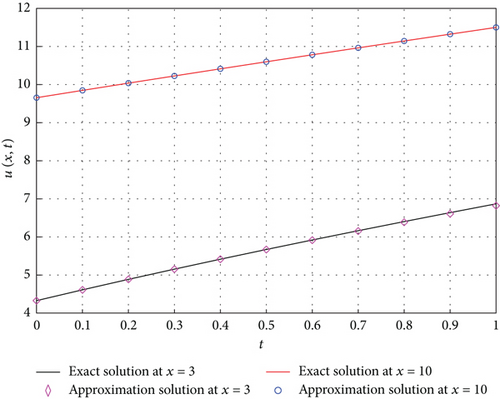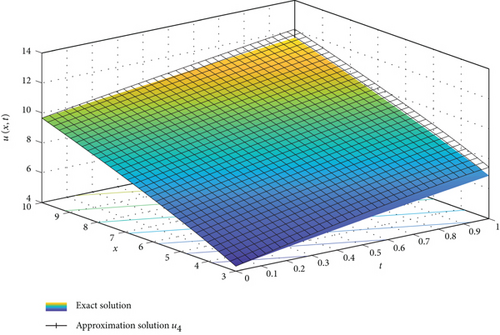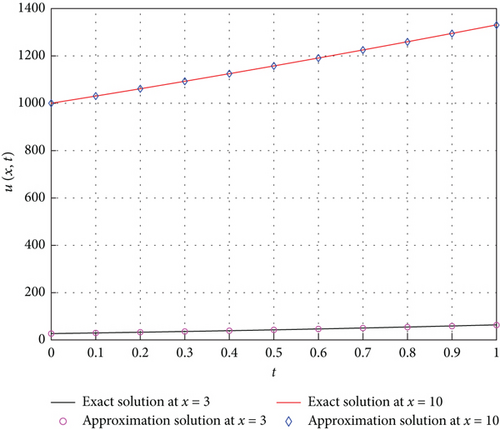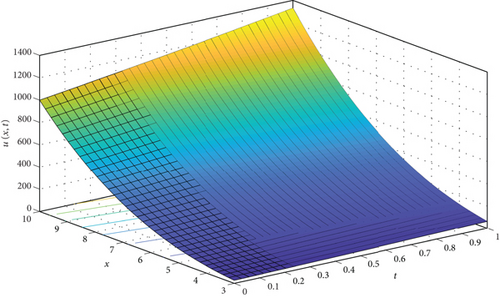Approximate Solution of an Integrodifferential Equation Generalized by Harry Dym Equation Using the Picard Successive Method
Abstract
In this study, we discuss the approximate solution of the Harry Dym nonlinear partial differential equation and its integrodifferential version. We first construct the Picard successive approximation for the equations under consideration. Then, we give a detailed calculation of the approximate solution for two cases of the partial Harry Dym integrodifferential equation. The approximate solutions are illustrated for some chosen values of the arbitrary constants. The efficiency of this semianalytical method is demonstrated through discussing the regions of the domain with small errors as well as by extracting the exact solution from the limit of the approximation.
1. Introduction
The semianalytical methods have become a popular approach to manipulate both ordinary and partial nonlinear differential equations. The Picard iteration method has been widely used by researchers to calculate the solution, Robin studied the solutions of partial and ordinary differential equations using this iteration method [1], and Bildik introduced comparison study between Picard successive and modified Krasnoselskii iteration to solve the initial value problem of ordinary differential equations [2]. Moreover, the study of Turab utilizes this method to compute the numerical solution of ordinary integrodifferential equations with initial conditions [3].
Lal employed the Picard successive method to solve some problems of nonlinear ordinary differential equations with boundary conditions; their study concluded that this method is accurate and efficient [4]; on the other hand, Yassein presented a study that used an iterative method to solve the ordinary integrodifferential equations in high order, and the solution found was a series that approached the exact solution [5].
Recently, the iteration method has been widely employed to deal with partial differential equations or combine it with some integral transforms, such as the Abdulazeez study, which obtained an analytic solution of a pseudohyperbolic telegraph partial differential equation in fractional order [6]. Also, the Mohammed study solved the nonlinear KdV-type partial differential equation [7].
Ma [9] considered an extended Harry Dym equation. The study of Gonzalez-Gaxiola, Ju, and Ed [10] introduced a new iterative method to obtain an approximate analytical solution to the Harry Dym equation. The study determined that this method was efficient and accurate. Matviichuk [11] dealt with this equation via the theory of finite–dimensional dynamics method, and the exact solution has been obtained. Kumar, Singh, and Kılıçman [12] introduced a study of the nonlinear time fractional Harry Dym equation, which processed the problem in two techniques. Assabaai [13] employed the Lie symmetry group method and Chebyshev spectral method to derive the numerical approximation of the solution of the classical Harry Dym equation (Equation 1), the first was based on the homotopy perturbation method and integral transform, and they used He’s polynomial for the nonlinear part; secondly, they used the Adomian decomposition method to calculate the solution. In their study, they showed that the solutions obtained using the two approaches agreed. Furthermore, Huang and Zhdanov [14] studied the fractional Harry Dym equation with Riemann–Liouville derivative; also, Rawashdeh [15] studied the fractional Harry Dym equation by the fractional reduced differential transform method.
2. Picard Successive Method
In this section, we present the Picard successive approximations of the HDPID (Equation 2).
3. The Approximate Solution of the Integropartial Differential Equation
The aim of this section is to calculate approximate solutions for the integrodifferential Harry Dym equation using the Picard successive approximations method. We also describe how can the exact solution be extracted from the limit of the approximation. We will consider two cases to define the functions f(u) and g(x) in the HDPDE (Equation 2).
Case 1.
Then, the resulted integrodifferential equation (Equation 2) also admits the same solution defined in Equation (12).
Next, n = 2.
Finally, by continuing this procedure, we obtain the successive approximation un which leads in the limit as n⟶∞ to the expansion of the exact solution defined in Equation (11); hence, the exact solution has been obtained.
Case 2. In this case, we define the functions f(u) and g(x) as
4. Illustrating Examples
In this section, we introduce two examples of the HDNID (Equation (2)) corresponding to Case 1 and Case 2 of defining the functions f(u) and g(x).
Example 1. In this example, the approximate solution will be calculated for Equation (2) with the case
Following the procedure presented in the previous section, the first four approximations have the forms as shown in Table 1.
| n | The approximate solutions |
|---|---|
| 0 | |
| 1 | |
| 2 | |
| 3 | |
| 4 |
In Figure 1, we present 2D and 3D graphs, for the 4th approximation plotted against the exact solution. The figures show how close the approximate solution is to the exact solution in the domain 0 ≤ t ≤ 1 and 3 ≤ x ≤ 10, and it shows well approximation of the exact solution in the selected region of the domain. Examples of the numeric values of the exact solution, approximate solution, and the error between them are given in Table 2. The error increases as t increases and x decreases due to the proportion of the approximation terms to the variables t and x.


| n | t | Exact | 4th order | Error |
|---|---|---|---|---|
| 1 | 0.0 | 9.6549 | 9.6549 | 0.0000 |
| 2 | 0.1 | 9.8470 | 9.8470 | 0.0000 |
| 3 | 0.2 | 10.0373 | 10.0373 | 0.0000 |
| 4 | 0.3 | 10.2258 | 10.2258 | 0.0000 |
| 5 | 0.4 | 10.4126 | 10.4126 | 0.0000 |
| 6 | 0.5 | 10.5977 | 10.5977 | 0.0000 |
| 7 | 0.6 | 10.7812 | 10.7812 | 0.0000 |
| 8 | 0.7 | 10.9632 | 10.9631 | 0.0001 |
| 9 | 0.8 | 11.1437 | 11.1436 | 0.0001 |
| 10 | 0.9 | 11.3227 | 11.3225 | 0.0002 |
| 11 | 1.0 | 11.5003 | 11.4999 | 0.0004 |
Example 2. In this example, the approximate solution will be calculated for Equation (2) with the case
For the constants’ values a = 0, b = 1, c = 1, then the initial condition is
According to the analysis of Case 2 in the previous section, the approximations of the solution are given as follows (Table 3).
| n | The approximate solutions |
|---|---|
| 0 | |
| 1 | |
| 2 | |
| 3 |
In Figure 2, we present 2D and 3D graphs, for the 2nd approximation plotted against the exact solution. The figures show how close the approximate solution is to the exact solution in the domain 0 ≤ t ≤ 1 and 0 ≤ x ≤ 10, The figure shows a good approximation of the exact solution in the selected region of the domain. Examples of the numeric values of the exact solution, approximate solution, and the error between them are given in Table 4.


| n | t | Exact | 2nd order | Error 2nd order | 3rd order | Error 3rd order |
|---|---|---|---|---|---|---|
| 1 | 0.0 | 27.000 | 27.00 | 0.000 | 27.000 | 0.00 |
| 2 | 0.1 | 29.791 | 29.79 | 0.001 | 29.791 | 0.00 |
| 3 | 0.2 | 32.768 | 32.76 | 0.008 | 32.768 | 0.00 |
| 4 | 0.3 | 35.937 | 35.91 | 0.027 | 35.937 | 0.00 |
| 5 | 0.4 | 39.304 | 39.24 | 0.064 | 39.304 | 0.00 |
| 6 | 0.5 | 42.875 | 42.75 | 0.125 | 42.875 | 0.00 |
| 7 | 0.6 | 46.656 | 46.44 | 0.216 | 46.656 | 0.00 |
| 8 | 0.7 | 50.653 | 50.31 | 0.343 | 50.653 | 0.00 |
| 9 | 0.8 | 54.872 | 54.36 | 0.512 | 54.872 | 0.00 |
| 10 | 0.9 | 59.319 | 58.59 | 0.729 | 59.319 | 0.00 |
| 11 | 1.0 | 64.000 | 63.00 | 1.000 | 64.000 | 0.00 |
5. Discussion
The detailed analysis presented in Section 3 and Section 4 shows that the suggested semianalytic technique is effective to obtain approximate and exact solution of the proposed nonlinear integropartial differential equations. The technique starts with transforming the integropartial differential equation into an integral representation. Then, the approximate solutions derived from the Picard successive method through iterative integration process. The output of this process is polynomials of the variable t with coefficients depending on x. In order to maintain a well representation of the approximation, all terms in the approximation having a power of the variable t higher than the iteration index is considered noise to be neglected. The resulted approximation then can be shown to coincide with the Taylor polynomial of the exact solution in the variable t. Therefore, the exact solution can be induced from the limit of the approximate solution as a Taylor expansion.
Some key issues to mention here are the dependence of the iterative process on the choice of the initial condition to construct successive approximations that lead clearly to the Taylor expansion of the exact solution. An effective way to achieve that is to neglect the high-degree terms in each iteration. Given an appropriate choice of the initial condition, the resulted approximations can be compared directly to the Taylor polynomial of the exact solution. Although the exact solution can be induced from the limit of the iteration as a Taylor expansion, the resulted Taylor power series might not converge on all the domains of the variables t and x.
As described in Case 1 of Section 3 and illustrated in Example 1, the variable t appears in the numerator of the terms in the approximation while the variable x appears in the denominator, except for the first term. Therefore, the terms are directly proportional to t and conversely proportional to x. Hence, the convergence of the resulted approximation is associated with small values of the variable t and large values of the variable x which is to decrease the errors (see Table 2). On the other hand, in Case 2 and Example 2, the resulted Taylor expansion is a polynomial, which converges for all the values of the variables t and x (see Table 4).
6. Conclusion
The nonlinear partial integrodifferential equations, a generalized version of the Harry Dym partial differential equation, are solved by using the Picard successive method, which provides an explicit iterative process to generate The presented analysis shows the effectiveness of the method in extracting the exact solution of the problem given an appropriate choice of the initial condition, and the study concludes that the same traditional solution is obtained when using the same initial condition, however, with variations in the arbitrary constant values. Moreover, when terms that are added to the classical equation vanish under certain conditions, the technique is still effective and gives the results that are mentioned in the literature review.
Furthermore, the study considers different types of cases. The Picard method gives the solution in polynomial form, which tends to be the exact solution.
The limitations of the method have also been presented by discussing the convergence conditions that restrict the values of the independent variables. A detailed description of the process has been included and illustrated with representative examples.
Conflicts of Interest
The author declares no conflicts of interest.
Funding
The author declares that he has no sources of funding (institutional, private, and corporate financial support) for the work reported in his manuscript.
Acknowledgments
This work is supported by the College of Basic Education at the University of Mosul, Iraq.
Open Research
Data Availability Statement
The author confirms that the data supporting the findings of this study are available within the article.




